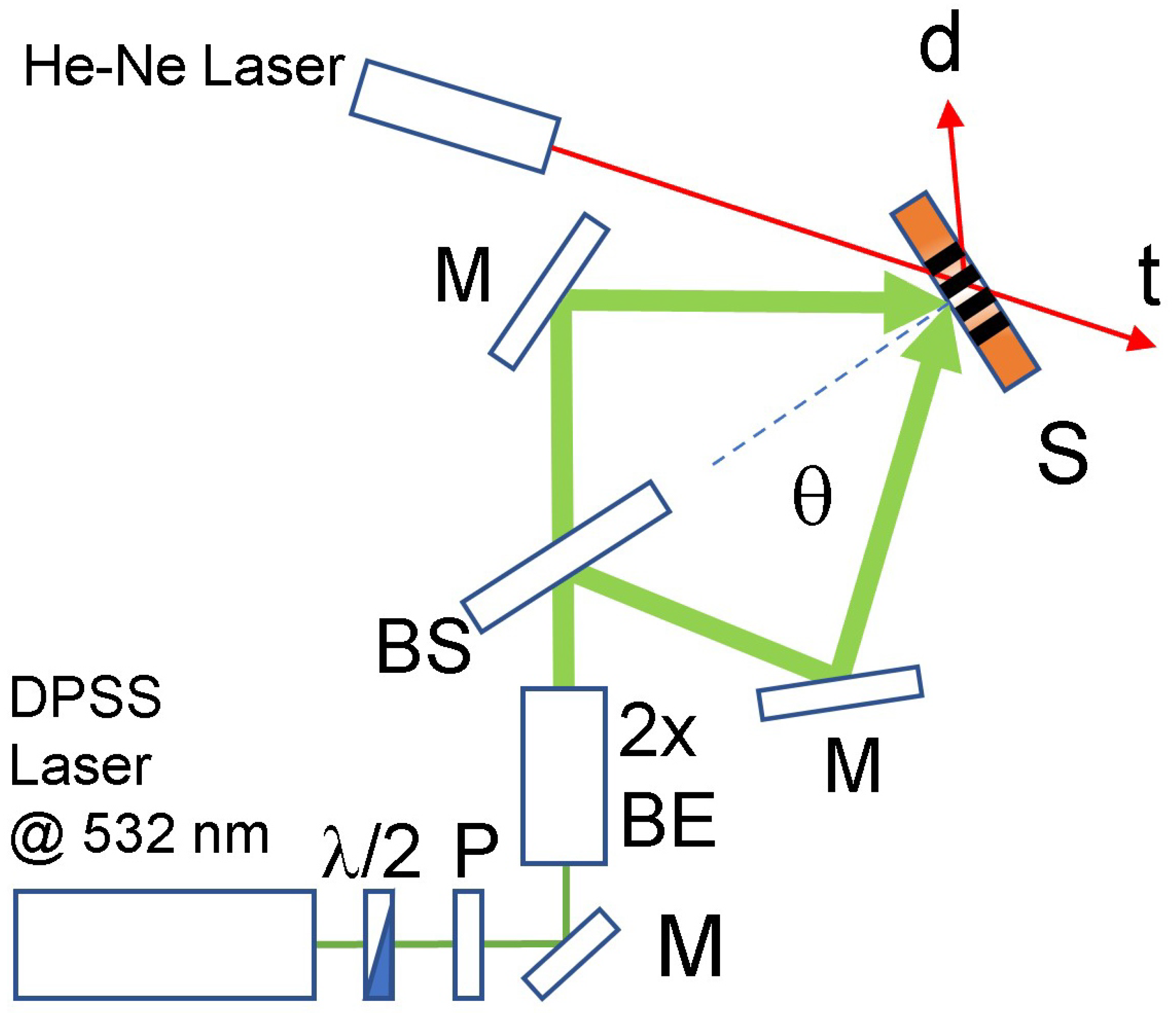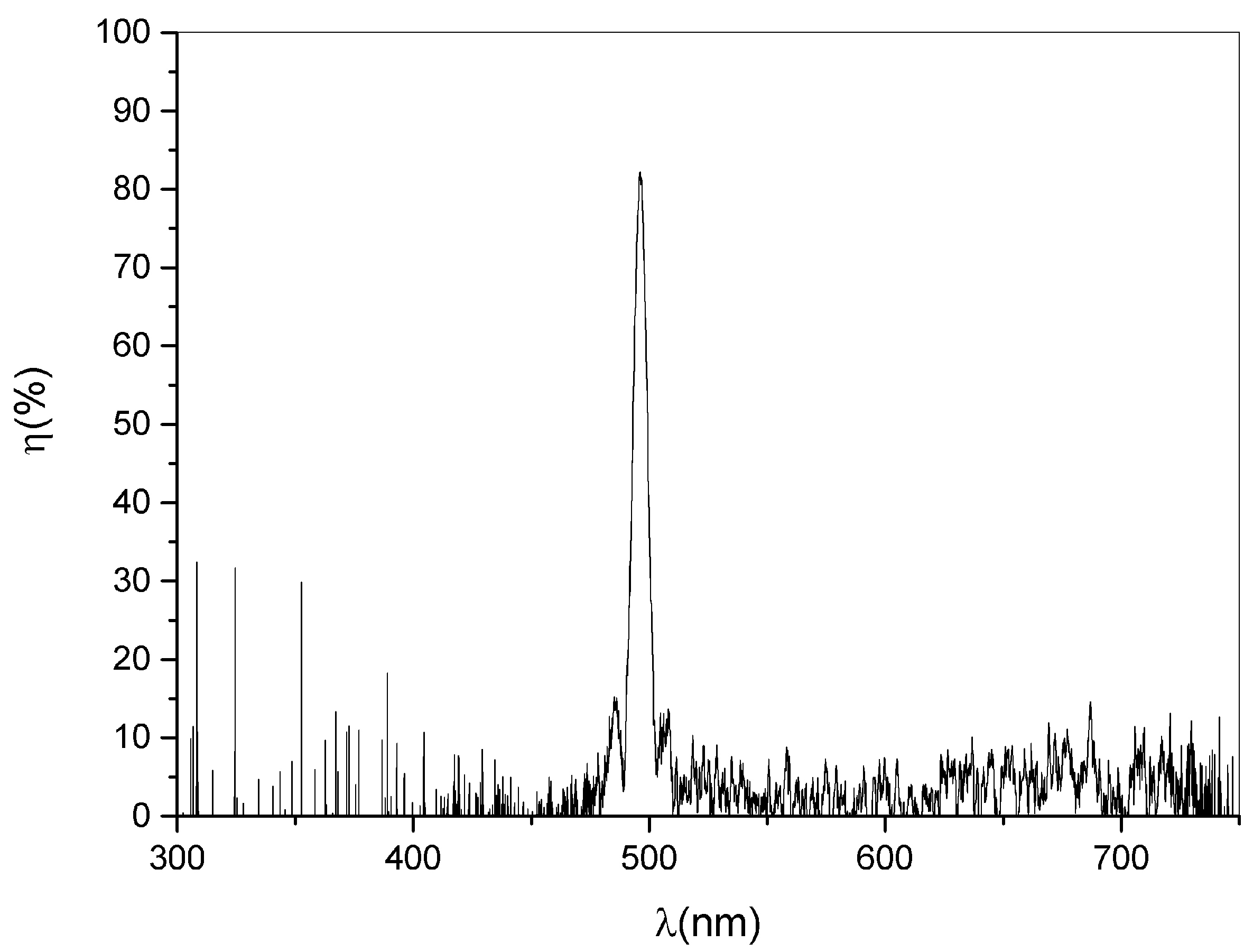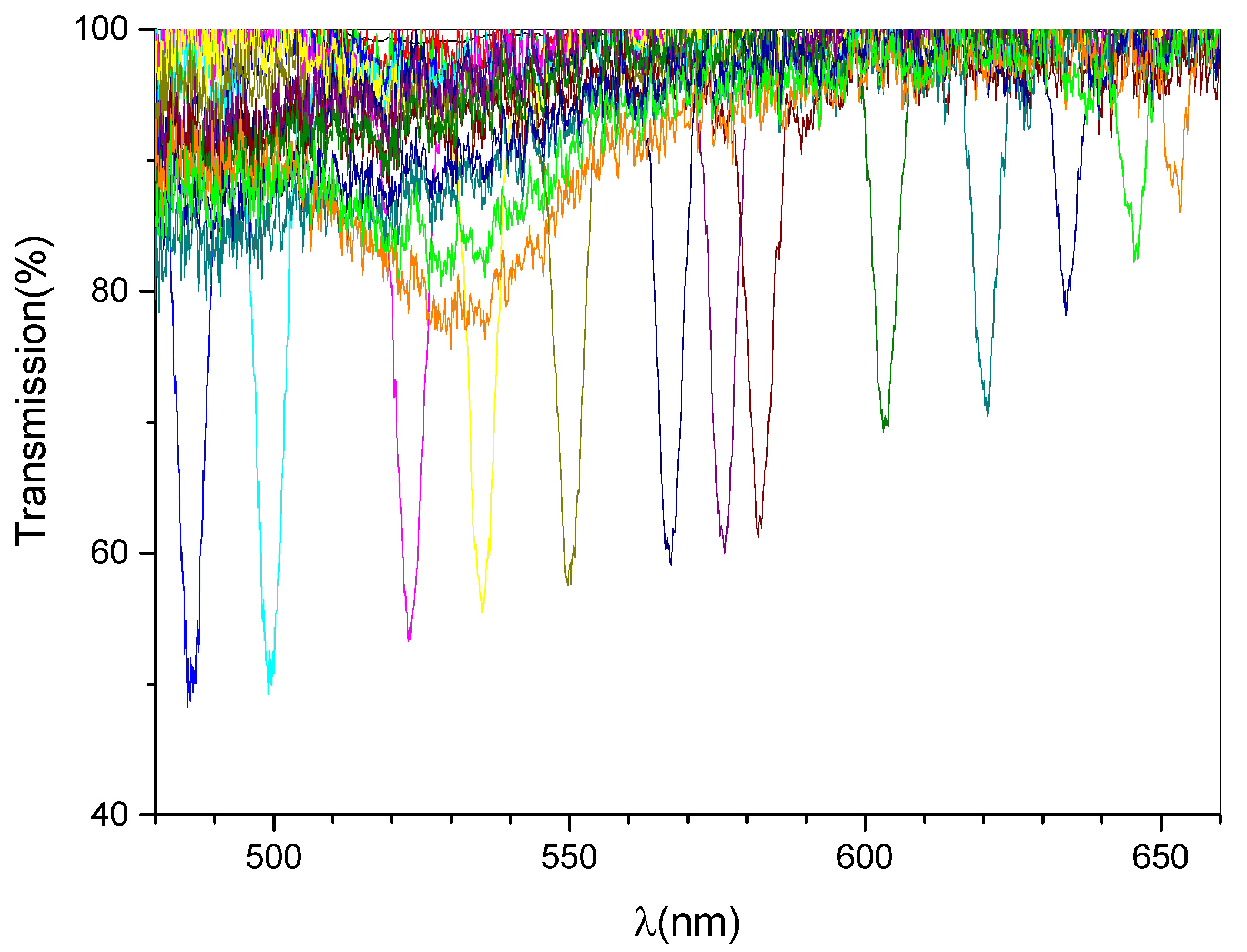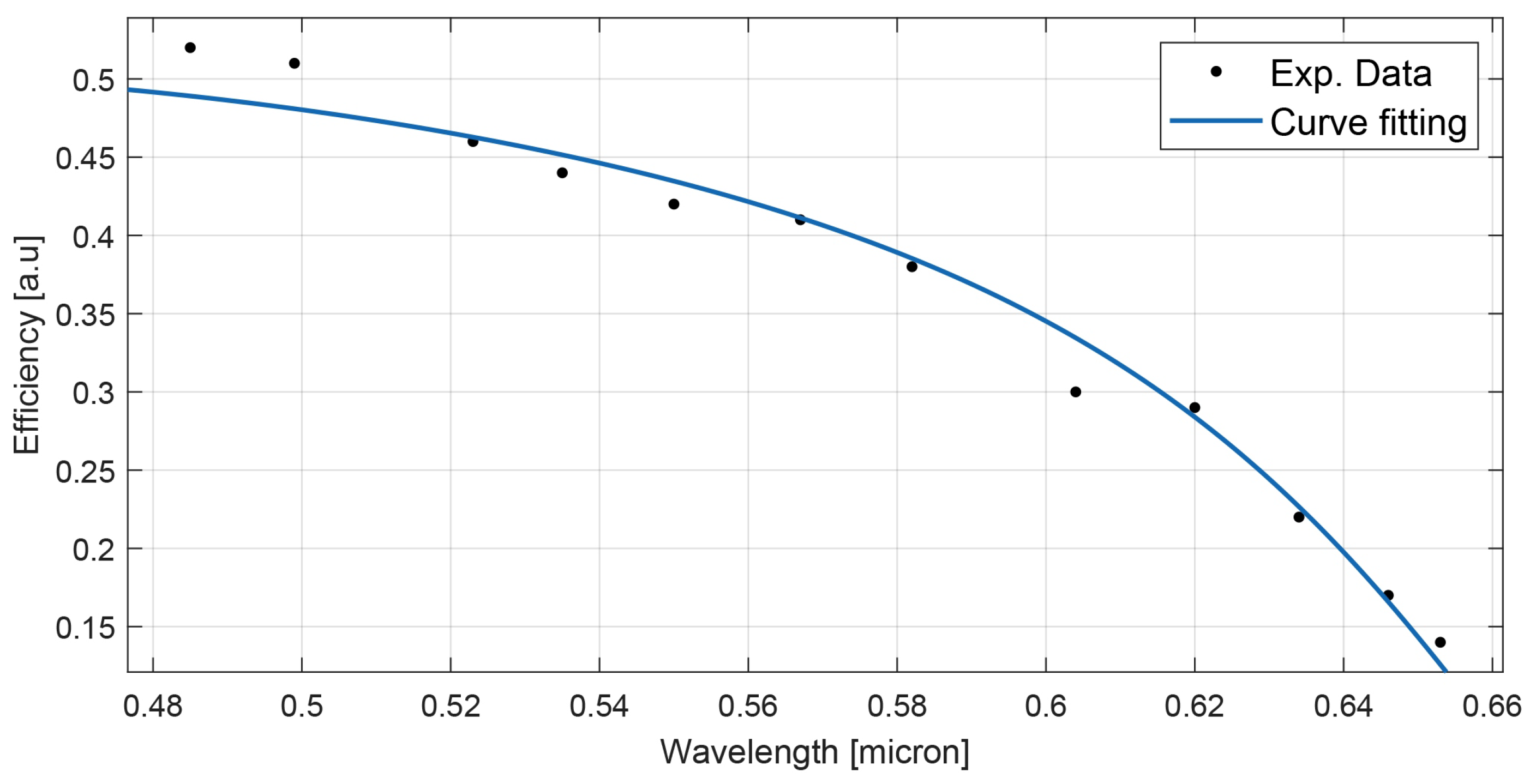Top-Performance Transmission Gratings with Haloalkanes-Based Polymeric Composite Materials
Abstract
1. Introduction
2. Materials and Methods
2.1. Materials
2.2. Methods
2.3. Sample Preparation
2.4. Holographic Set-up
3. Results and Discussion
4. Conclusions
Author Contributions
Funding
Institutional Review Board Statement
Informed Consent Statement
Data Availability Statement
Acknowledgments
Conflicts of Interest
References
- Biswal, T.; BadJena, S.K.; Pradhan, D. Synthesis of polymer composite materials and their biomedical applications. Mater. Today Proc. 2020, 30, 305–315. [Google Scholar] [CrossRef]
- Tuttle, M. Structural Analysis of Polymeric Composite Materials, 2nd ed.; Chapman Hall/CRC Applied Env., Taylor & Francis: Oxfordshire, UK, 2012. [Google Scholar]
- Tsuchiya, H.; Asaki, Y.; Sinawang, G.; Asoh, T.A.; Osaki, M.; Park, J.; Ikemoto, Y.; Yamaguchi, H.; Harada, A.; Uyama, H.; et al. Cellulose Nanofiber Composite Polymeric Materials with Reversible and Movable Cross-links and Evaluation of their Mechanical Properties. ACS Appl. Polym. Mater. 2022, 4, 403–412. [Google Scholar] [CrossRef]
- Hsissou, R.; Seghiri, R.; Benzekri, Z.; Hilali, M.; Rafik, M.; Elharfi, A. Polymer composite materials: A comprehensive review. Compos. Struct. 2021, 262, 113640. [Google Scholar] [CrossRef]
- Palermo, G.; Rippa, M.; Conti, Y.; Vestri, A.; Castagna, R.; Fusco, G.; Suffredini, E.; Zhou, J.; Zyss, J.; De Luca, A.; et al. Plasmonic Metasurfaces Based on Pyramidal Nanoholes for High-Efficiency SERS Biosensing. ACS Appl. Mater. Interfaces 2021, 13, 43715–43725. [Google Scholar] [CrossRef] [PubMed]
- Oladele, I.O.; Omotosho, T.F.; Adediran, A.A. Polymer-Based Composites: An Indispensable Material for Present and Future Applications. Int. J. Polym. Sci. 2020, 2020, 8834518. [Google Scholar] [CrossRef]
- Rippa, M.; Castagna, R.; Pannico, M.; Musto, P.; Tkachenko, V.; Zhou, J.; Petti, L. Engineered plasmonic Thue-Morse nanostructures for LSPR detection of the pesticide Thiram. Nanophotonics 2017, 6, 1083–1092. [Google Scholar] [CrossRef]
- Luiz, R.; Campos, D.; Delgado, F.; Santos, A. Long-period fiber grating embedded in polymer structure for deformation monitoring. Appl. Phys. B 2021, 127. [Google Scholar] [CrossRef]
- Tomita, Y.; Aoi, T.; Hasegawa, S.; Xia, F.; Wang, Y.; Oshima, J. Very high contrast volume holographic gratings recorded in photopolymerizable nanocomposite materials. Opt. Express 2020, 28, 28366–28382. [Google Scholar] [CrossRef]
- Stoilova, A.; Mateev, G.; Nazarova, D.; Nedelchev, L.; Stoykova, E.; Blagoeva, B.; Berberova, N.; Georgieva, S.; Todorov, P. Polarization holographic gratings in PAZO polymer films doped with particles of biometals. J. Photochem. Photobiol. A Chem. 2021, 411, 113196. [Google Scholar] [CrossRef]
- Liao, Y.Y.; Liu, J.H. Holographic gratings formed in photosensitive polymer materials with a liquid crystalline monomer. React. Funct. Polym. 2009, 69, 281–286. [Google Scholar] [CrossRef]
- Levi, O.; Shalom, S.; Benjamin, I.; Perepelitsa, G.; Agranat, A.; Neumann, R.; Avny, Y.; Davidov, D. Conjugated Polymeric Composites for Holographic Storage. Synth. Met. 1999, 102, 1178–1181. [Google Scholar] [CrossRef]
- Ono, H.; Kawamura, T.; Mocam Frias, N.; Kitamura, K.; Kawatsuki, N.; Norisada, H.; Yamamoto, T. Holographic Bragg grating generation in photorefractive polymer-dissolved liquid-crystal composites. J. Appl. Phys. 2000, 88, 3853–3858. [Google Scholar] [CrossRef]
- Hadden, E.; Iso, Y.; Kume, A.; Umemoto, K.; Jenke, T.; Fally, M.; Klepp, J.; Tomita, Y. Nanodiamond-based nanoparticle-polymer composite gratings with extremely large neutron refractive index modulation. In Photosensitive Materials and Their Applications II; McLeod, R.R., Pascual Villalobos, I., Tomita, Y., Sheridan, J.T., Eds.; Society of Photo-Optical Instrumentation Engineers (SPIE) Conference Series; SPIE: Bellingham, WA, USA, 2022; Volume 12151, p. 1215109. [Google Scholar] [CrossRef]
- Hasegawa, M.; Yamamoto, T.; Kanazawa, A.; Shiono, T.; Ikeda, T.; Nagase, Y.; Akiyama, E.; Takamura, Y. Real-time holographic grating by means of photoresponsive polymer liquid crystals with a flexible siloxane spacer in the side chain. J. Mater. Chem. 1999, 9, 2765–2769. [Google Scholar] [CrossRef]
- Lucchetta, D.; Vita, F.; Francescangeli, D.; Francescangeli, O.; Simoni, F. Optical measurement of flow rate in a microfluidic channel. Microfluid. Nanofluid. 2016, 20, 9. [Google Scholar] [CrossRef]
- Castagna, R.; Lucchetta, D.E.; Rippa, M.; Xu, J.H.; Donato, A.D. Near-frequency photons Y-splitter. Appl. Mater. Today 2020, 19, 100636. [Google Scholar] [CrossRef]
- Shalit, A.; Lucchetta, D.; Piazza, V.; Simoni, F.; Bizzarri, R.; Castagna, R. Polarization-dependent laser-light structured directionality with polymer composite materials. Mater. Lett. 2012, 81, 232–234. [Google Scholar] [CrossRef]
- Lucchetta, D.; Spegni, P.; Di Donato, A.; Simoni, F.; Castagna, R. Hybrid surface-relief/volume one dimensional holographic gratings. Opt. Mater. 2015, 42, 366–369. [Google Scholar] [CrossRef]
- Rajan, G.; Peng, G. 8—Polymer micro and microstructured fiber Bragg gratings: Recent advancements and applications. In Optofluidics, Sensors and Actuators in Microstructured Optical Fibers; Pissadakis, S., Selleri, S., Eds.; Woodhead Publishing: Sawston, UK, 2015; pp. 207–227. [Google Scholar] [CrossRef]
- He, J.; Kovach, A.; Wang, Y.; Wang, W.; Wu, W.; Armani, A.M. Stretchable optical diffraction grating from poly(acrylic acid)/polyethylene oxide stereocomplex. Opt. Lett. 2021, 46, 5493–5496. [Google Scholar] [CrossRef]
- Dai, X.; Xie, H. New methods of fabricating gratings for deformation measurements: A review. Opt. Lasers Eng. 2017, 92, 48–56. [Google Scholar] [CrossRef]
- Gao, J.; He, Y.; Liu, F.; Zhang, X.; Wang, Z.; Wang, X. Azobenzene-Containing Supramolecular Side-Chain Polymer Films for Laser-Induced Surface Relief Gratings. Chem. Mater. 2007, 19, 3877–3881. [Google Scholar] [CrossRef]
- Lucchetta, D.E.; Donato, A.D.; Singh, G.; Castagna, R. Lasing in Haloalkanes-based polymeric mixtures. Opt. Mater. 2022, 131, 112614. [Google Scholar] [CrossRef]
- Castagna, R.; Lucchetta, D.; Vita, F.; Criante, L.; Greci, L.; Simoni, F. Haloalkane-based polymeric mixtures for high density optical data storage. Opt. Mater. 2008, 30, 1878–1882. [Google Scholar] [CrossRef]
- Lucchetta, D.E.; Di Donato, A.; Francescangeli, O.; Singh, G.; Castagna, R. Light-Controlled Direction of Distributed Feedback Laser Emission by Photo-Mobile Polymer Films. Nanomaterials 2022, 12, 2890. [Google Scholar] [CrossRef] [PubMed]
- do Rego, A.M.B.; Ferreira, L.F.V. Chapter 7—Photonic and electronic spectroscopies for the characterization of organic surfaces and organic molecules adsorbed on surfaces. In Handbook of Surfaces and Interfaces of Materials; Nalwa, H.S., Ed.; Academic Press: Burlington, NJ, USA, 2001; pp. 275–313. [Google Scholar] [CrossRef]
- Lucchetta, D.; Criante, L.; Simoni, F. Optical characterization of polymer dispersed liquid crystals for holographic recording. J. Appl. Phys. 2003, 93, 9669–9674. [Google Scholar] [CrossRef]
- Lucchetta, D.; Criante, L.; Simoni, F. Determination of small anisotropy of holographic phase gratings. Opt. Lett. 2003, 28, 725–727. [Google Scholar] [CrossRef]
- Castagna, R.; Vita, F.; Lucchetta, D.E.; Criante, L.; Simoni, F. Superior-Performance Polymeric Composite Materials for High-Density Optical Data Storage. Adv. Mater. 2009, 21, 589–592. [Google Scholar] [CrossRef]





Publisher’s Note: MDPI stays neutral with regard to jurisdictional claims in published maps and institutional affiliations. |
© 2022 by the authors. Licensee MDPI, Basel, Switzerland. This article is an open access article distributed under the terms and conditions of the Creative Commons Attribution (CC BY) license (https://creativecommons.org/licenses/by/4.0/).
Share and Cite
Castagna, R.; Riminesi, C.; Di Donato, A.; Francescangeli, O.; Lucchetta, D.E. Top-Performance Transmission Gratings with Haloalkanes-Based Polymeric Composite Materials. Materials 2022, 15, 8638. https://doi.org/10.3390/ma15238638
Castagna R, Riminesi C, Di Donato A, Francescangeli O, Lucchetta DE. Top-Performance Transmission Gratings with Haloalkanes-Based Polymeric Composite Materials. Materials. 2022; 15(23):8638. https://doi.org/10.3390/ma15238638
Chicago/Turabian StyleCastagna, Riccardo, Cristiano Riminesi, Andrea Di Donato, Oriano Francescangeli, and Daniele Eugenio Lucchetta. 2022. "Top-Performance Transmission Gratings with Haloalkanes-Based Polymeric Composite Materials" Materials 15, no. 23: 8638. https://doi.org/10.3390/ma15238638
APA StyleCastagna, R., Riminesi, C., Di Donato, A., Francescangeli, O., & Lucchetta, D. E. (2022). Top-Performance Transmission Gratings with Haloalkanes-Based Polymeric Composite Materials. Materials, 15(23), 8638. https://doi.org/10.3390/ma15238638






